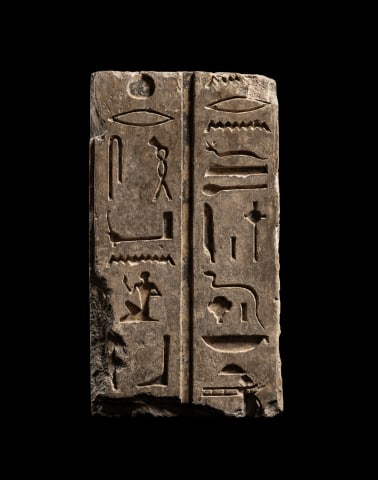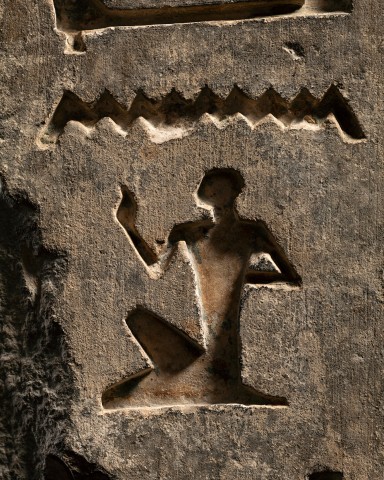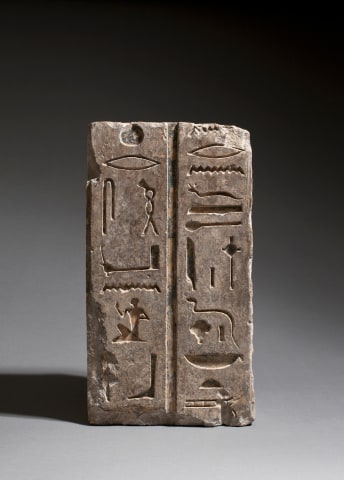Egyptian hieroglyphic relief for Bakenrenef, Late Dynastic Period, 26th Dynasty, c.664-610 BC
Limestone
Height: 32.5cm, width: 18.4cm
11852
Further images
Two columns of incised hieroglyphs for the Vizier Bakenrenef, picked out in blue pigment. An address to a goddess, the text reads ‘Bakenrenef, true of voice, hail to you, Lady...
Two columns of incised hieroglyphs for the Vizier Bakenrenef, picked out in blue pigment. An address to a goddess, the text reads ‘Bakenrenef, true of voice, hail to you, Lady of Nebet(?)...’. The undetermined text could read ‘Nebet Temw’; the name of a lion- headed snake goddess. Chipping to the edges, some blue pigment remaining. An accompanying old mount with label which reads ‘Piece of Tomb of .... (Bakenranef) XXVth Dynasty. Presented by John Waterhouse Esq. EG.34’
Porter and Moss note doorposts at the tomb of Bakenrenef with addresses to a deity; this may be a fragment of one such doorpost.
Bakenrenef served as Vizier of the North to Psamtek I during Egypt’s 26th Dynasty (circa 664–610 BC). As vizier, he held one of the highest-ranking positions in the kingdom, overseeing civil administration, legal matters, and priestly duties. He bore the ritual title Iunmutef, linking him to sacred temple functions. Bakenrenef is best known for his elaborately decorated rock-cut tomb at Saqqara, near the Step Pyramid, featuring texts from the Book of the Dead and Amduat, along with painted scenes of him before various deities. Though the tomb was cut into poor-quality rock, its artistic and religious content reflected the Saite Renaissance’s revival of earlier Egyptian styles. Several statues of Bakenrenef survive, including one in the Boston Museum of Fine Arts and others in European museums, depicting him in traditional poses that emphasize his priestly and administrative authority during Psamtik's reign.
Psamtik I united Egypt for the final time, bringing in the 26th Dynasty and the start of the Late Dynastic Period. He was Pharaoh from 664-610 BC. After his father Necho I was killed by Kushite forces, Psamtik fled but returned with Assyrian support to expel the Kushites and regain control of Memphis and Thebes, uniting Upper and Lower Egypt by 656 BC. He strengthened Egypt’s military by employing Greek and Carian mercenaries, reformed administration, and maintained strategic alliances, including with Lydia. Psamtik also launched a cultural and economic renaissance, reviving art in the style of earlier dynasties, promoting trade, restoring temples, and expanding infrastructure. Religiously, he solidified power in Thebes by installing his daughter Nitocris I as “God’s Wife of Amun.” His reign, marked by both stability and innovation, lasted 54 years and laid the foundation for a brief resurgence of Egyptian power before later Persian conquest.
Porter and Moss note doorposts at the tomb of Bakenrenef with addresses to a deity; this may be a fragment of one such doorpost.
Bakenrenef served as Vizier of the North to Psamtek I during Egypt’s 26th Dynasty (circa 664–610 BC). As vizier, he held one of the highest-ranking positions in the kingdom, overseeing civil administration, legal matters, and priestly duties. He bore the ritual title Iunmutef, linking him to sacred temple functions. Bakenrenef is best known for his elaborately decorated rock-cut tomb at Saqqara, near the Step Pyramid, featuring texts from the Book of the Dead and Amduat, along with painted scenes of him before various deities. Though the tomb was cut into poor-quality rock, its artistic and religious content reflected the Saite Renaissance’s revival of earlier Egyptian styles. Several statues of Bakenrenef survive, including one in the Boston Museum of Fine Arts and others in European museums, depicting him in traditional poses that emphasize his priestly and administrative authority during Psamtik's reign.
Psamtik I united Egypt for the final time, bringing in the 26th Dynasty and the start of the Late Dynastic Period. He was Pharaoh from 664-610 BC. After his father Necho I was killed by Kushite forces, Psamtik fled but returned with Assyrian support to expel the Kushites and regain control of Memphis and Thebes, uniting Upper and Lower Egypt by 656 BC. He strengthened Egypt’s military by employing Greek and Carian mercenaries, reformed administration, and maintained strategic alliances, including with Lydia. Psamtik also launched a cultural and economic renaissance, reviving art in the style of earlier dynasties, promoting trade, restoring temples, and expanding infrastructure. Religiously, he solidified power in Thebes by installing his daughter Nitocris I as “God’s Wife of Amun.” His reign, marked by both stability and innovation, lasted 54 years and laid the foundation for a brief resurgence of Egyptian power before later Persian conquest.
Provenance
John Waterhouse Esq.William Ohly (1883-1955), London, UK; acquired 1940s-1950s, for his private museum, The Abbey Arts Centre, 89 Park Road, New Barnet, UK
Bienchen Ohly, London, UK; by descent from the above, her father
Douglas Barrett, UK; acquired from the above
Charles Ede Ltd, London, UK; acquired from the above, 2nd October 2014
Private Collection, London, UK; acquired from the above, 26th June 2015
The Abbey Art Centre and Museum was established in 1946 by William Ohly, an art dealer who ran the Berkeley Galleries in Davies Street, London.





